I have always been a fan of energy efficiency . Those compact fluorescent lamp(CFL) which people love to hate just don’t bother me at all. I have lived through the blink-blink starter pre-heat type to the “delayed-start” preheat type, right up to the modern instant start type lamps, watching the price plummet from above $40 per globe to about$4.
Naturally, you do lose some with the CFL – it takes a while to get to full brightness(mins when it is really cold), some don’t really start up immediately – instead taking 2 seconds or so warn the filaments. The colour rendering of the CFLS are variable – and can be poor in the case of bargain basement no brand globes, and it makes photography tricky.
But even at the high price point, the globes featured convenience which made them the globe of choice in my house – the long lifetime of 6000 hours to 15,000 hours reduce the amount of labour involved in changing the globes. The energy saving over incandescent are dramatic, with the CFLs using about 20% of the energy compared to an incandescent. Add to that, the cost of the globes, and the cost of cooling (in summer), then you are more than miles ahead.
Lately, vast improvements in white LED efficiency and cost has made LED light globes a reality, but is it really worthwhile?
The product
With end-of- financial-year sales, Kogan has expanded into offering LED light globes. They are selling them in 2-packs, discounted at a cost $29.0 with free shipping (normally $39.0 + shipping), I decided to give them a go.
LED light globes have been available for a while from Chinese shopping site such as DealXtreme and I had always meant to give them a go – but how do you know which ones are good? It is hard to tell without trying. Some could be had for about $8 or so. We have been all too much disappointed by poor LED light source for a variety of reasons:
- Early LED globes used a large number of low-quality, low-current, low-brightness, small-viewing-angle 5 mm LEDs. Sometimes these were connected in large series strings, such that id any one LED failed, a large segment of the globe would be failed or flicker(in case of an intermittent heat-related failure of a joint). They also threw out light all over, without a very well defined illumination area, and were aesthetically lacking as they appeared to have LEDs with different colour and brightness scattered within the large number of LEDs. The lifetime of these globes did not even meet that of the CFLs, it was aiming to replacing.
- Later LED globes used fewer large, high powered LEDs which were better quality. Some were still overdrive and appear blue, and some suffered from heat dissipation problems. The use of high powered LEDs meant that the light from these globes was harsh and riddled with hot spots where glare and uniformity of the intensity was poor. The smaller illumination angle also meant that in some luminaries, the light just did not reach where it was needed.
- Many of these globes were also under-powered, with the LED powers inflated and equivalency factors overstated to the point as to ensure disappointment.
- Finally, as people had complained of the color rendering with CFLs, the color rendering of early low-cost white LEDs was also lamentable.
Let us hope these globes are not as bad as some of the ones I have seen.
Buying them from Kogan does mean paying a bit of premium – $ 14.50 each. But this is without the uncertainty of the DealXtreme offering , and without the month ot two wait! The bulbs by Australia Post eParcel – I could not wait to give them a go!
The front of the box clearly states the 8W wattage, with a 30,000 hour lifetime(about 3 – 4 years continuous operation). It also claims a 60 W equivalency with just 620 lumens(really likely closer to 50 W). This is a bit optimistic as the EU guideline say 700-810 lumens is about 60 W equivalence.
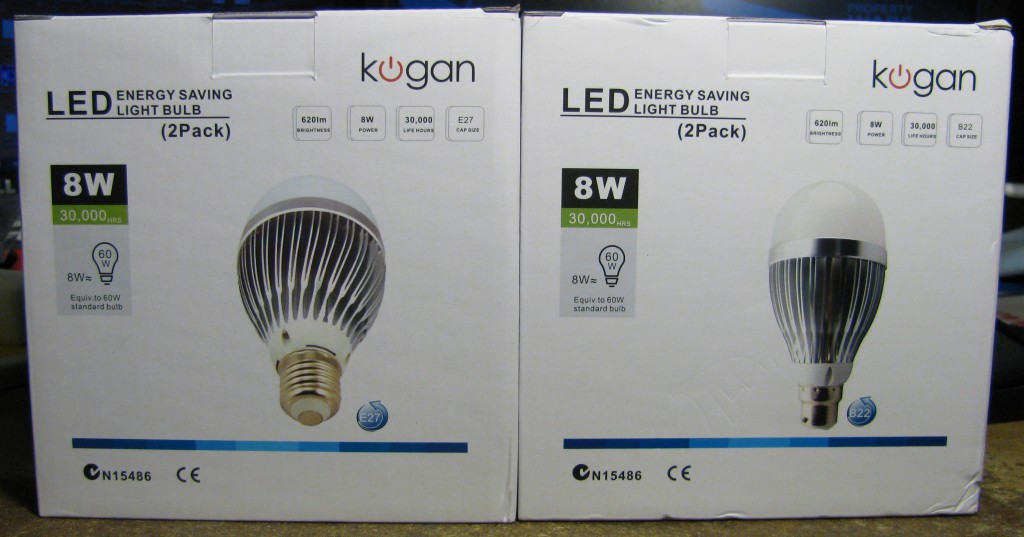
Seeing I was going to test one in my desk lamp, the existing IKEA 11W CFL is rated at 600 lumens . A good match to compare to! The 11W CFL is about 50 -55W equivalence.
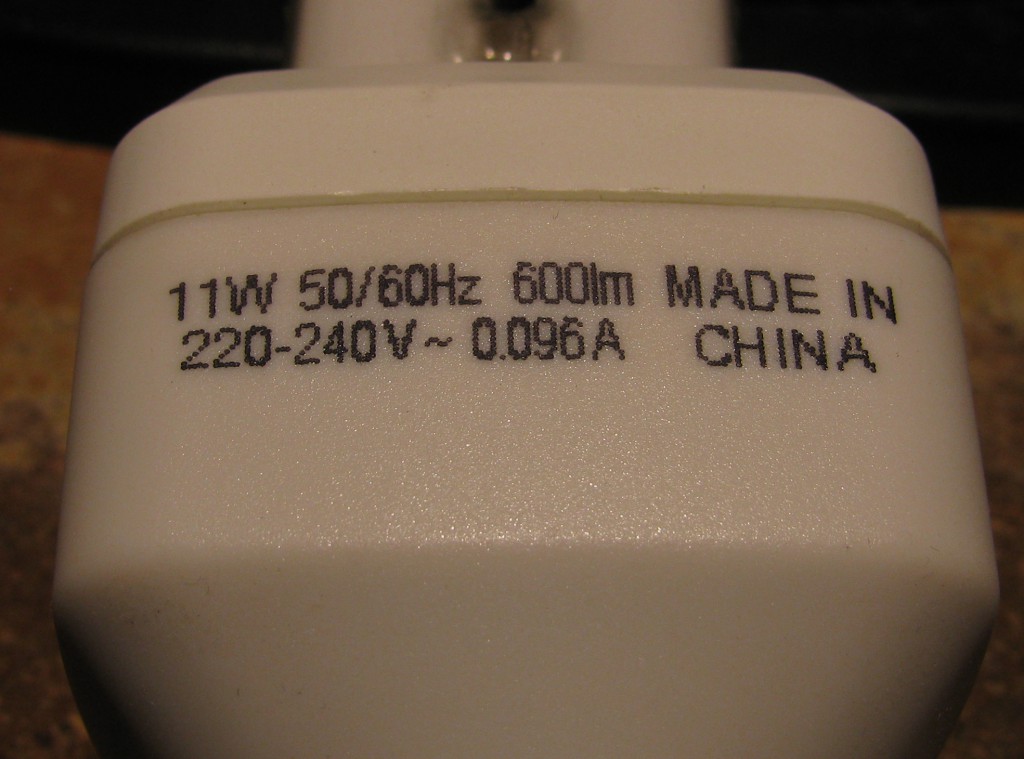
The back of the box does not really add much, but it does tell you to keep your boxes if you want to claim warranty on the said LED globes. Sadly , Kogan ‘s regular warranty is only one year, meaning that they really are warranted for 8,760 hours at the most (one year continuous operation). That is not more than a regular CFL.
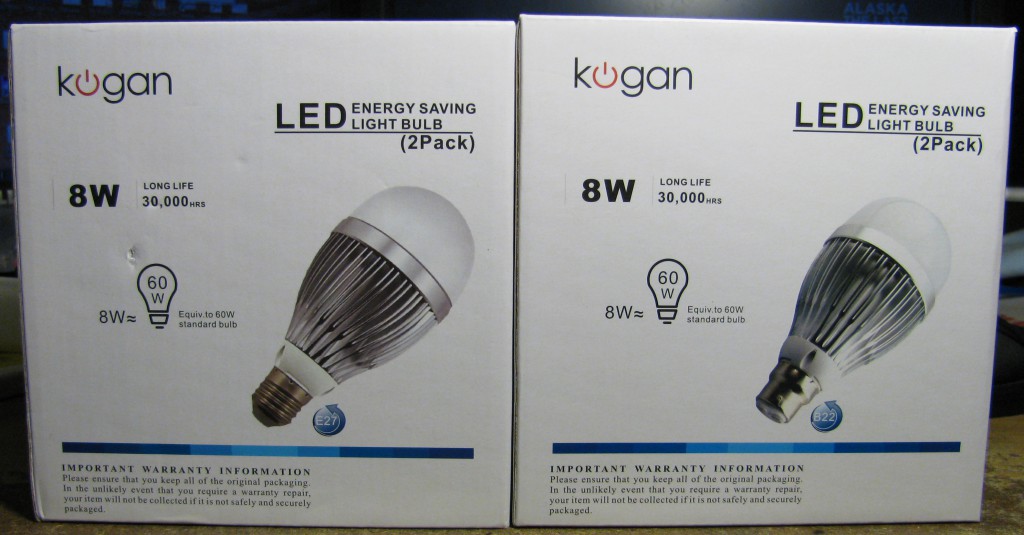
Lets take a look at the side of the box.
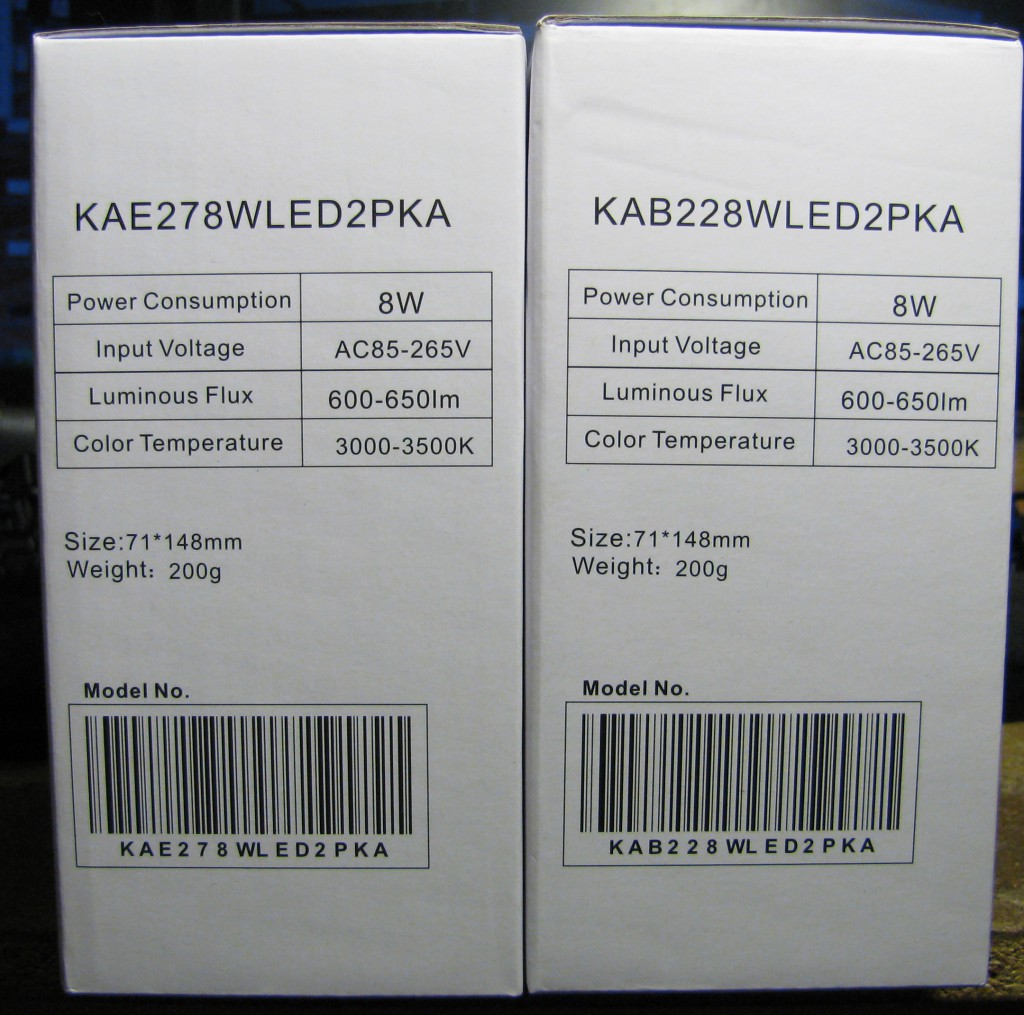
One side provides the specs, interestingly, the globes are 200 gram(rather hefty for a globe), likely because of the heat sinking fins. The luminous flux is stated at 600 – 650 lumens (rather than the 620 lumen figure given on the front) – not surprising since the actual luminous flux will depend on operating temperature and the tolerances on each LED ! The light globes run on a very wide range, and basically is compatible with all mains power around the world. Cool.
The other side of the box.
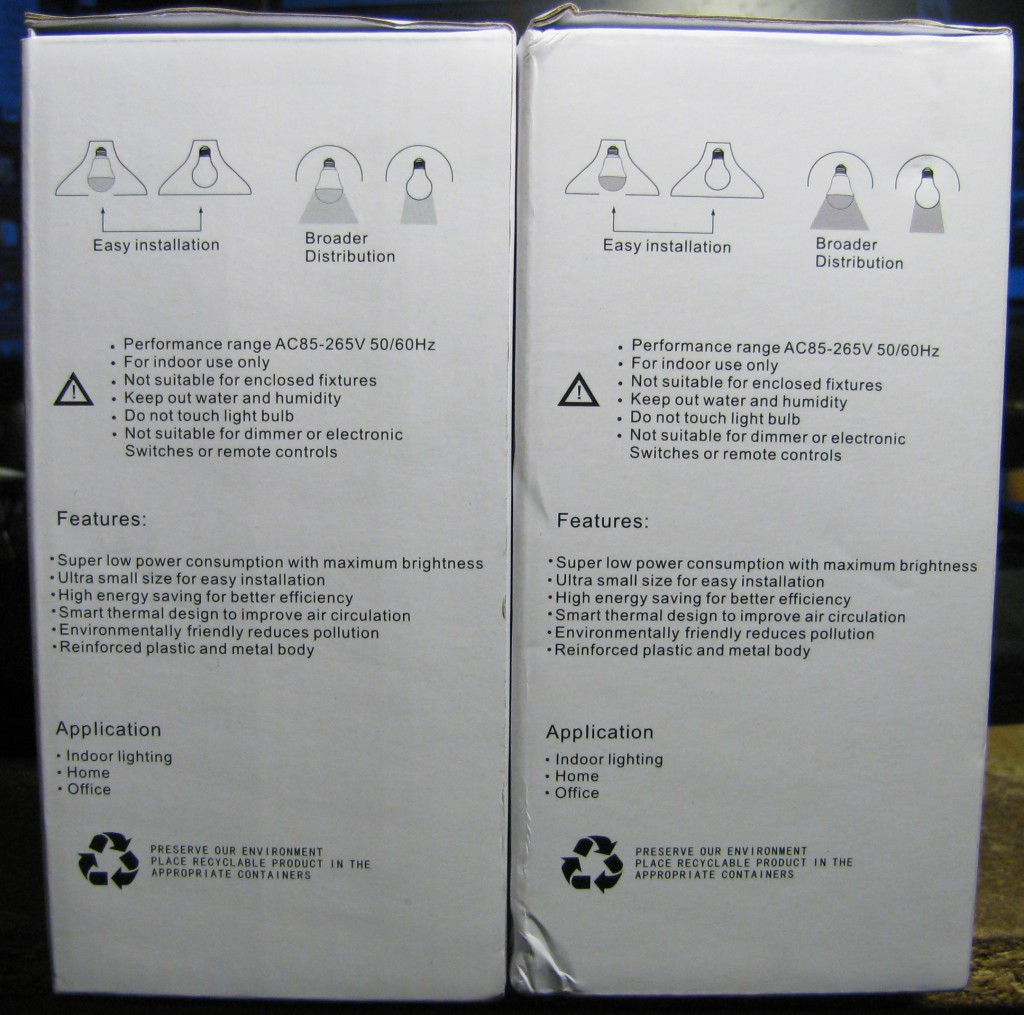
Tries to imply that these light globes are easy to install(compare to what?) and have a broader distribution of light. Really? A regular incandescent pushes light in all directions except the cap – they probably mean a wider beam compared to early LED lamps. It warns not to use it in humid, wet and outdoor areas, and not to use it with dimmer switches, electronic switches or remote controls. This is likely due to leakage currents causing flickering/flashing/ballast wear.
The warning “do not touch light globe” seems to be inconsistent – given most of the globe is metal and plastic. There really is not a reason not to touch it, it seems as if it is been taken of something with a halogen globe where finger oils cause lamp explosions.
Inside the box, each globe is individually packed in a plain cardboard box. Nice!
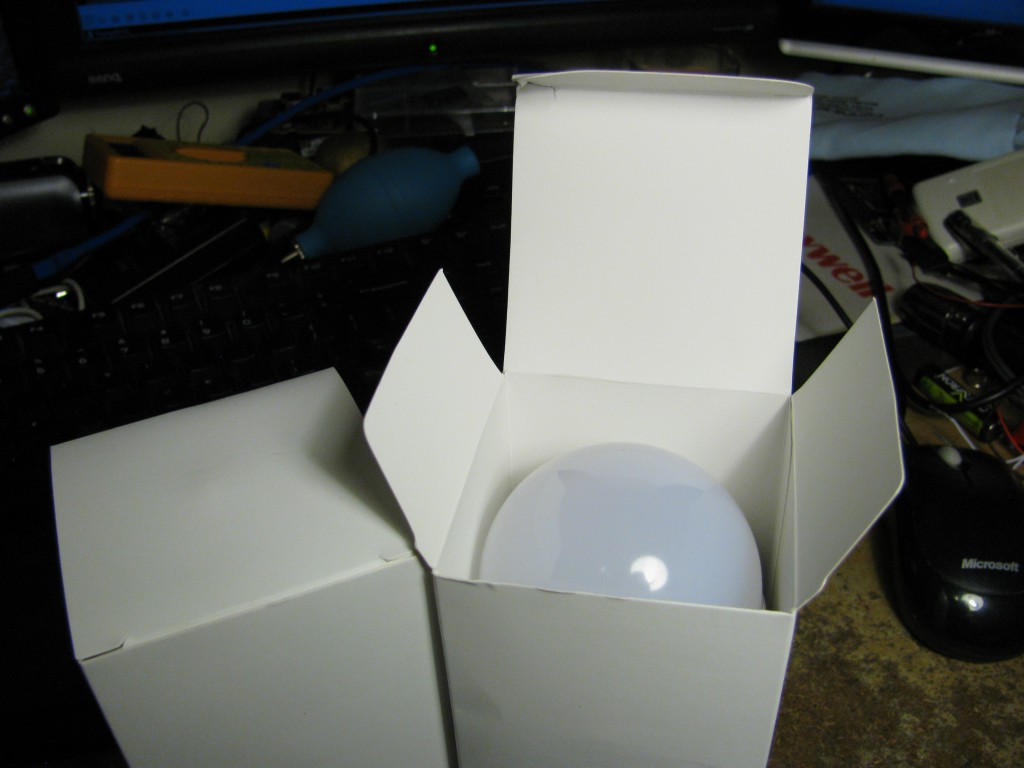
The globe itself is pretty much as pictured.
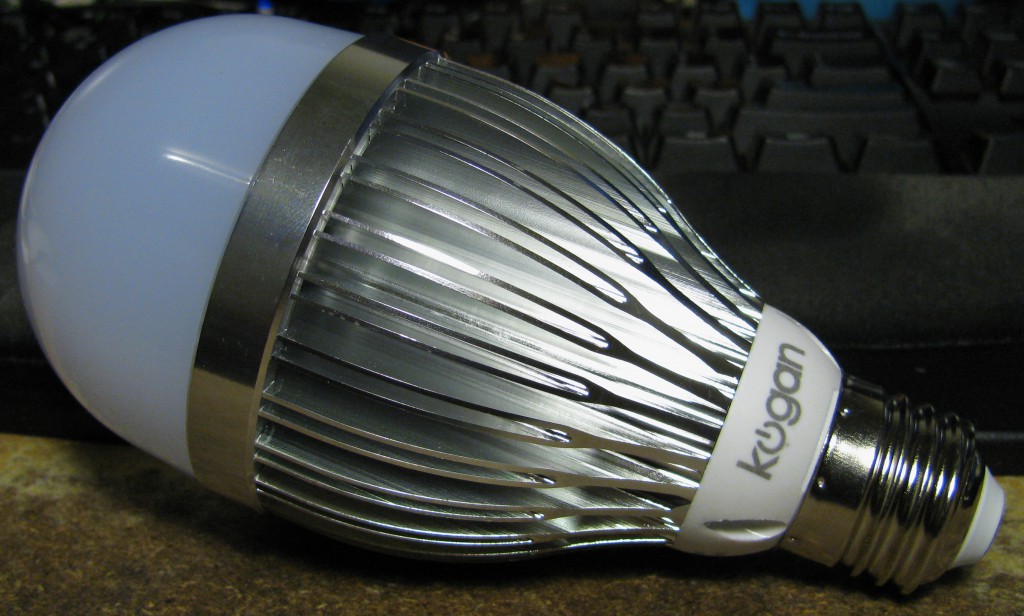
It is vaguely light globe shaped, just a little taller. This could make fitting it into some luminaries difficult – just as with CFLs. The printing has been customized for Kogan with their branding and model numbers.
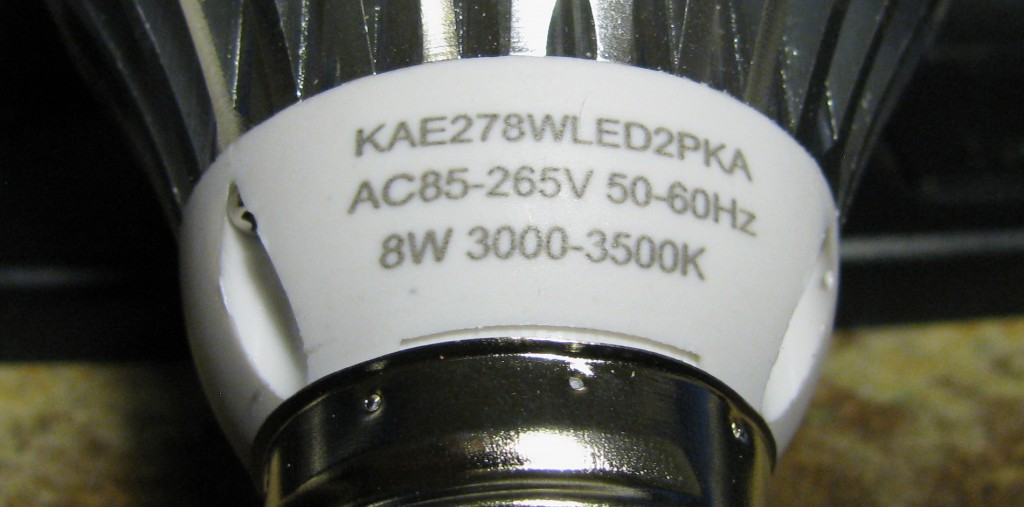
Teardown
In comes to the Gough Instinct – When you get something new, the first thing you really want to do is take it apart! So here is a tear down, to make a better informed review.
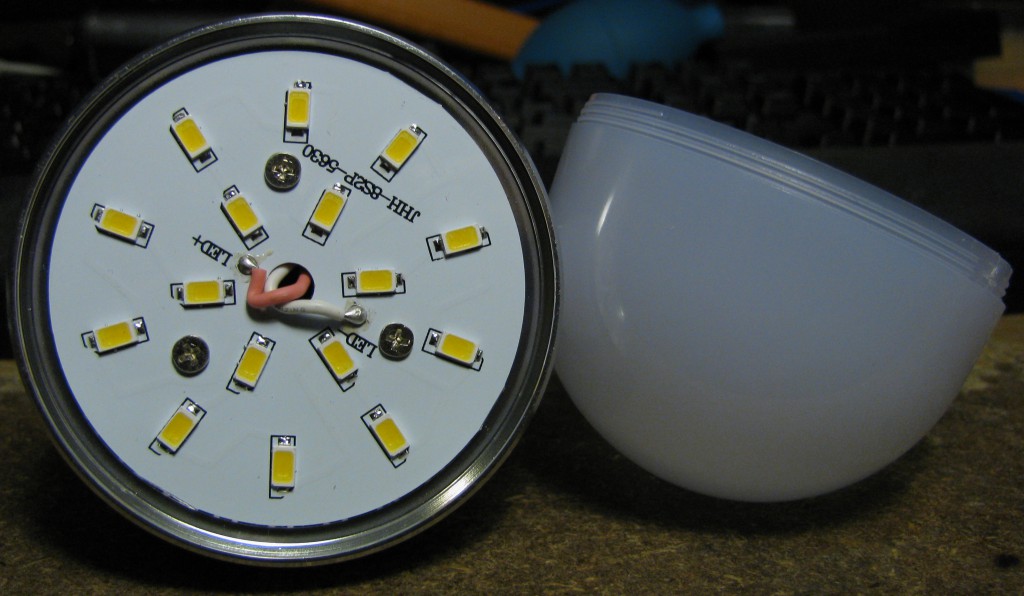
The front is very easy to remove – it merely screws off, not being secured by any adhesive or anything. The reveals the main metal- core printed circuit board(MCPCB) which is used for thermal management reasons. This suggested some care in manufacture. There are sixteen separate surface mounted 5630 type LEDs. Unfortunately, I do not know who makes the LEDs, as that has a bearing on what the LED are capable of. The wires from the ballast are soldered onto two contacts on the MCPCB, with three screws holding the MCPCB against the fined heatsink.
For the 620 lumen claim to be true, each LED must manage 38.75 lumnes. If we look at the Philips Lumileds 5630 Mid-Power LED datrasheet, we can see that their 35ook MXL8-PW35-0000 LED managees a typical luminous flux of 34 lumens at 100 mA at 25 degrees Celsius. Given that the LED can be operated up to 150mA, the luminous flux at 150mA is 1.4 times greater. But the LED will heat up, reducing the output – at 100 degrees Celsius, the output is about 85%. So that gives us 34 x 1.4 x 0.85 = 40.46 lumen. So, is the 620 lumen figure correct? Probably, provided good quality LEDs used.
The markings on the MCPCB are HHH-8S2P-5630. The letter JHH imply that the light is manufactured by Shenzhen Gevon Lighting Co.Ltd. You can see this in their pictures, the JHH logo is in the top left – with the very similar product linked above. The description of that suggests 8 X 1W LEDs, whereas this is more like 16 x 0.5 w. But I am still pretty confident that I have tracked down the OEM!
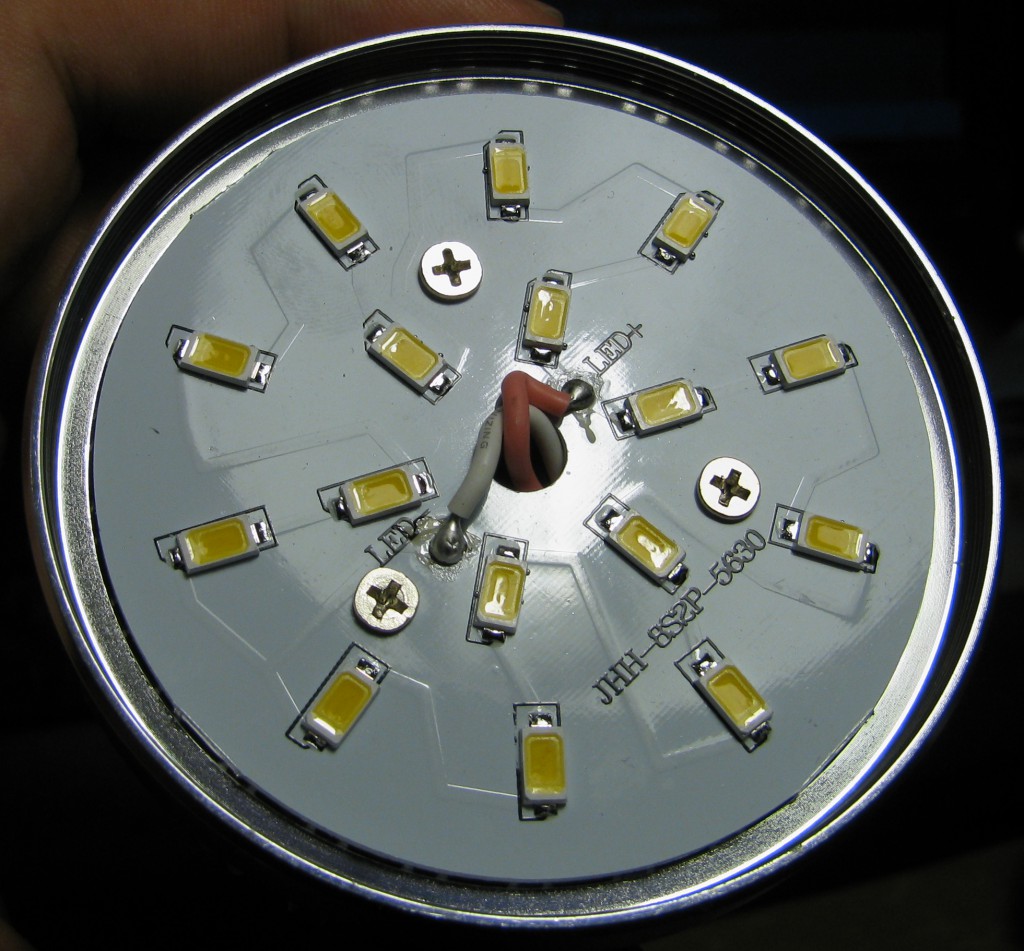
A look at the MCPCB at an angle reveals the trace layout. It can be seen that eight LEDs are connected in series, with two parallel strings. This is why the MCPCB has the log 8S2P marked on. Unfortunately, this design is not a good thing. Electrical Engineers should know why immediately!
Basically put, the ballast will be provided a constant current supply of about 300mA. The two parallel LED strings cannot be guaranteed to have the same voltage drop – due to tolerances, mismatch, different aging, different temperature. This would mean that the current is not evenly shared amongst both parallel string! This can lead to the premature degradation of one string before the other.
Furthermore, if one LED goes open circuit, one string will be entirely isolated, and the 300mA would be forced through the remaining string, likely causing a bright blue flash before failing entirely.
It do not have to be this way, you could just have a lower current supply in one string thus making the LED current matched and within spec, but if one LED fails, then the whole globe fails . Or you could have separate strings on separate ballasts. Or you could set up both strings with transistors linked to form a current mirrors to try and ensure even current sharing, although the tolerances of the transistors may bias this somewhat. All up, it is a set of compromises, but this one they have chosen does not really take my fancy much.
While I am her, I am might just quickly discuss the spectrum of white LEDs. As they are formed by using blue LEDs with a phosphor that converts some of the blue into a broad band of light, the color rendering of white LEDs could be quite good compared to the peaky spectrum of the fluoros. Here is a spectrum from that same Lumileds datasheet – notice how the balance of blue to phosphor converted light changes for the different color temperatures.
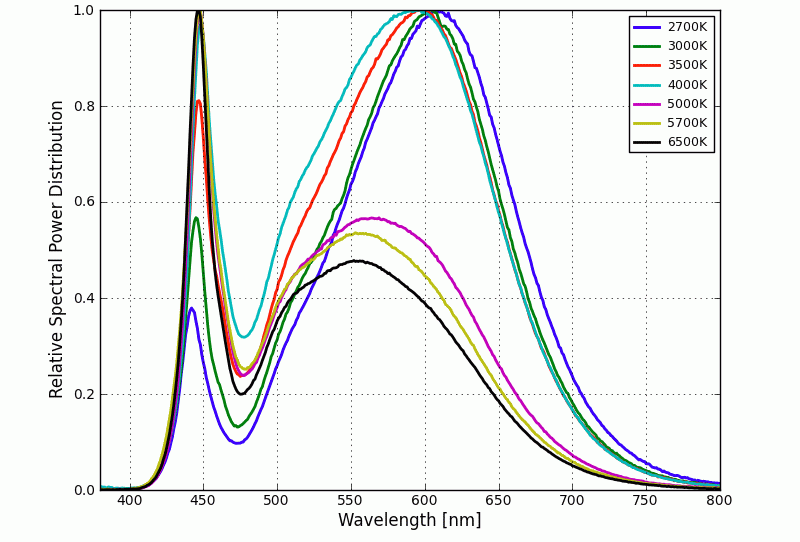
Okay, back to tear down, let us removes the screw to get the MCPCB off.
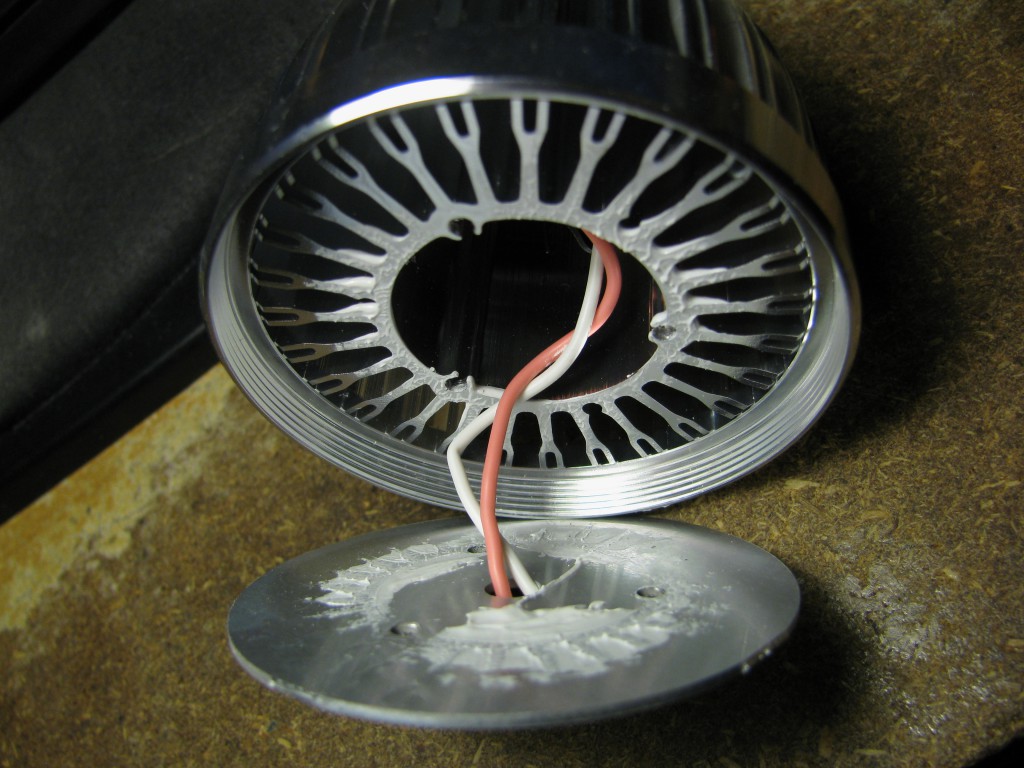
One thing I noted was the ease of screw removal. There is a problem, two of the three screws did not bite into the aluminium! This means that the pressure on the MCPCB fastening it to the heat sink fins is poor construction, but it may still be enough cooling to last, who knows. It would cost me more in postage to return and explain the problem.
Removal of the MCPCB shows the use of thermal paste for thermal conductivity between the MCPCB to the heat sink. The area for heat conduction is limited though, due to the desire to minimise aluminium use as it is expensive(embodied energy and price wise).
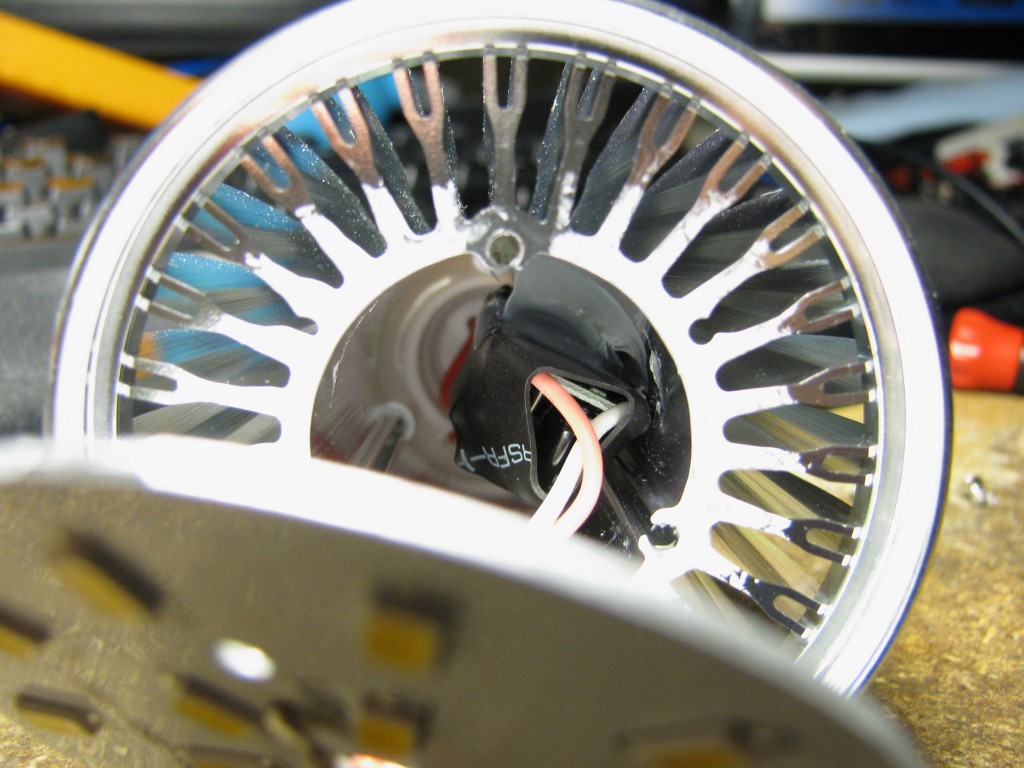
The ballast is glued inside the core, with heat sink over it. I can not really be bothered to take it further and cut off the heat shrink and glue to find out how the circuitry is built and what parts are used. All I know is that the globe works – and I do not want to break it just yet. One of the potential concerns for the ballast is its lifetime, while the LEDs may last(in theory), the capacitors(especially cheap ones) in the ballast may not!
Subjective Experience
How do I find the globe? Well, in a word, decent!
The globe is not quite instant start. On throwing the switch, it takes about 0.5 -0.8 seconds for the light to be produced. It is not quite as bad as early CFLs, but it is still a slight lag. The best part is that it comes on at full brightness right away. That is right, no warm up. In fact, the LEDs warm up, their output decrease. So instead, these globes might warm down? I am not kidding! The heat sink gets quite warm in operation, unscrewing the globe right after switch off is a bit of painful experience(although incandescent are worse!)
The light output is definitely equivalent to if not slightly better than my aged IKEA 11W CFL. I would say they probably are not lying about the lumen, but they are a bit optimistic on the equivalency. The light spectrum also seems relatively similar, with the IKEA being slightly warmer, and the LEDs being slightly yellow-greener. It is not a harsh blue like the overdrive LEDs in some torches, and the diffuser does a great job of eliminating hot spots.
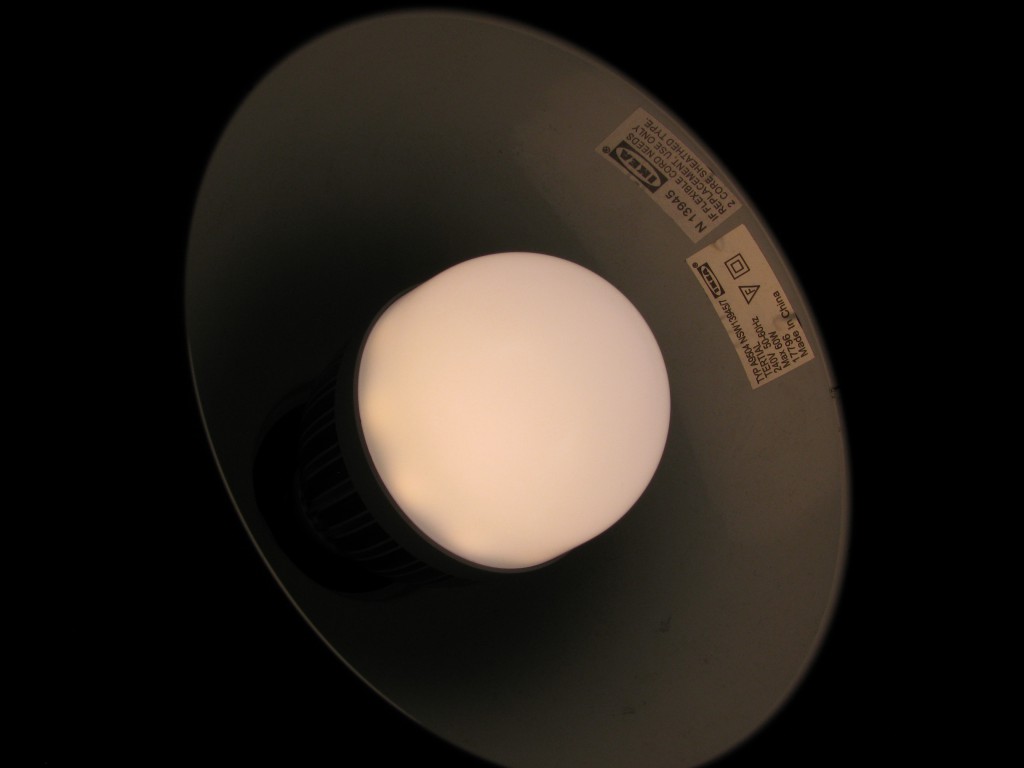
The globe itself is quiet, it makes no audible noise. Some very cheap CFLs have buzz or humm ballasts, and in a desk lamp, this can be quite annoying.
A great feature of LED based globes is the lack of fragile envelope which can break if you accidentally hit it against something, and the fact that LED globes do not have toxic mercury which can be hazardous if CFLs are broken.
The powering on and off of LEDs generally has no penalties, so it would probably be a great thing to use in desk lamps, toilets and other places where frequent cycling is expected. But I am not sure if the ballast itself is capable of handling it, but it should be!
Another benefit is a saving on power. The CFL is 11 W, the LED IS 8W, that is 3W difference. That might not seem much power wise, over 30,000 hours of the LED, the savings amoung to 90kwh which about $25.20. That is mote than the cost of the globe. Even if we factor in CFLs being $4 a piece, you would need 3.75 of them for 30,000 hours which is $15, more than the initial cost of the LED globe.
But this is all theoretical, it only holds true if the LED globe survives to 30,000 hours! Judging from the construction, this is a bit of a 50 -50 thing. On the other hand, unlike CFLs, if the LEDs are still well matched at that time, you would still have a functioning globe, although possibly at 80% of the original intensity.
With the given time, I can not verify lifetime, but I do like the way it works so far.
Conslusion
After taking it apart, it is a bit of a mixed bag.
The design and construction quality leaves a bit to be desired, but the actual performance is sufficient. It is a bit optimistic on its equivalency, so it is really only suitable where a moderate-low amount of light is needed, but it does bring quite a few advantages to the table. It is probably a good choice for where instant -intensity is required and on-off switching is frequent. The costs are actually not bad if it does make is to the 30,000 hours stated. Maybe it is time we gave LED lighting a go in our house, may be it is the next big thing in lighting since the fluorescent tube.
Original Post